Dextra’s Rebar Coupler Systems for concrete construction practices
By Edit Team | December 15, 2021 5:47 pm SHARE

This article is a technical note on Dextra’s coupling rebar systems being used as an alternative practice for traditional lap splices.
Reinforced concrete design and construction practise has historically focused on the use of lap splicing as a method of transferring load between reinforcement bars. This relies on the load being transferred from one rebar, through the surrounding concrete, and into the adjacent lapped rebar. However, the lapping of reinforcement is not always the most appropriate splicing method, and there are many situations where the use of mechanical rebar couplers is more desirable from a design perspective, more convenient from a construction perspective, or even both.
Rebar coupler systems, also known as mechanical splices, are used as an alternative to traditional lap splices in concrete. They transmit the rebar load directly from one rebar to another without relying on the concrete bond, concrete strength, or condition of the concrete surrounding the rebar and coupler.
Advantages
There are many well-documented advantages to using rebar coupler systems, including:
Rebar Continuity:
Reinforced concrete design codes of practice, including IS 456 [1], assume that the detailing, quality of materials, and workmanship are such that the transmission of forces in a lap splice from one rebar to the other is assured. However, if the bond between the concrete and the rebar is lost, possibly due to concrete cracking, deterioration, poor onsite workmanship, rebar corrosion and subsequent spalling, etc., then the rebar lap splice may fail. Rebar couplers do not rely on concrete bonding; therefore, they create more reliable rebar continuity.
Avoidance of Transverse Splitting Forces
Many structural concrete codes of practice recommend the use of rebar couplers as an alternative to lapping, particularly for large rebar diameters where splitting and dowel action forces can be significant. IS456 states that “lap splices shall not be used for bars larger than 36mm” and goes on to say that if there is no alternative, then lapping of large diameter bars should be accompanied by additional spirals along the lap length to act as confinement reinforcement.
Reduction of Rebar Congestion
Lapping rebar in heavily reinforced sections can cause significant congestion, resulting in problems fixing the steel and insufficient room for the proper placement and compaction of the concrete. Use of rebar couplers can significantly reduce congestion, making the placement and compaction of the concrete easier, leading to a lower risk of concrete segregation due to over vibration and, as a result, an increase in the concrete quality.
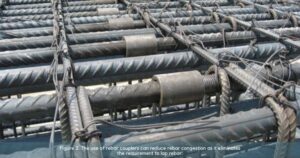
Safety
On site safety during construction is paramount and the use of rebar couplers can contribute to enhancing site safety.
- Rebar protruding through shuttering, which can be hazardous, can be eliminated by using couplers butted up against the shuttering or formwork, allowing the connection of the adjoining rebar after the shuttering or formwork is removed
- On-site welding of rebar can be eliminated by joining prefabricated cages with rebar couplers
As well as, construction site safety, rebar couplers are often seen as a safer alternative to lapping as they do not rely on concrete bonding and, therefore, they create more reliable rebar continuity; see Section 2.1.
Ease of Construction
The safety advantages of rebar couplers do not come at the expense of constructability. In fact, the use of rebar couplers can make on-site or off-site construction easier and faster, as well as safer.
- Prefabricated rebar cages can be easily connected on site, making on-site welding of rebar unnecessary.
- Individual concrete elements and construction joints can be joined without the need to drill through shuttering.
- The use of couplers allows the faces of concrete elements to remain smooth during construction, making construction easier and faster
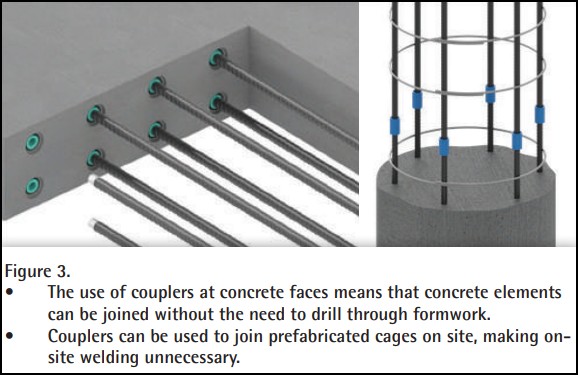
Steel Consumption Reduction
The use of rebar couplers reduces steel consumption and can therefore be an environmentally friendly and more sustainable option than lapping. The rebar steel saved is equivalent to the lap length.

Seismic Application
For major earthquakes, the design approach of IS 1893-1 [2] is to prevent the collapse of structures. Severe cracking and the degradation of concrete elements are therefore possible. In such cases, the bond between the rebar and the concrete may be compromised, and this in turn will compromise the ability of a lap splice to transfer load from one bar to another, and thus compromise the ability of the element to carry load. Mechanical rebar couplers do not rely on rebar bonding with the concrete to transfer the load from one bar to the other and are therefore often seen as a safer option than lap splicing for seismically designed structures.
If conventional lap splicing is employed, the seismic design of reinforced concrete structures will often exacerbate reinforcement congestion problems. In addition, the significant increase in lap lengths and other codified detailing requirements can lead to over-reinforced concrete and a potential for non-ductile, brittle behaviour at the lap splice region due to the concentration of stresses at both ends of the lap, inadvertently altering the elements’ deformation capacity. In such cases, the use of mechanical rebar couplers is therefore seen as a distinct advantage.
The ductility of reinforcement is of significant importance in seismic design, and the principal measurement of rebar ductility is the percentage elongation at maximum force, as defined in IS 1786 [3]. For rebar coupler systems conforming to IS 16172 [4], there is a ductility requirement for the adjoining rebar. However, this requirement is less than that given in IS 1786 because IS 16172 does not require a “bar break” level of rebar coupler performance, which would force the rebar to be loaded to its maximum force. Thus, for a rebar coupler system, the only way to retain the full rebar ductility is to ensure that it is not reduced in capacity as a result of a stress raiser or loss of rebar cross-section at the mechanical rebar coupler. In other words, the coupler needs to be what is commonly known as a “bar break” system. That is, a system that exceeds the ultimate tensile strength of the actual rebar it is connected to, ultimately forcing a tensile failure to occur in the rebar away from the influence of the coupler splice.
Full capacity “bar break” rebar coupler systems therefore provide both a strength and a ductility advantage over systems with a lower level of strength and are the only types of systems whereby the ductility of the connecting rebar is not compromised.
Summary of Benefits
Mechanical rebar couplers create a continuity of reinforcement that is not reliant on the quality or integrity of the concrete. Their use creates less rebar congestion, more convenient and often safer site practice, as well as reduces the amount of steel used. While different performance levels exist for rebar couplers, a guaranteed “bar break” coupler means that there will ultimately be no brittle failure in a “beyond design” event and the full ductility of the rebar will be maintained, a feature that is recommended in safety-critical applications or if the structure could be subject to impact damage or a seismic event.
Types of Coupler System
SP 34 and IS 16172 Annex A both describe some of the rebar coupler technologies available. In broad terms they can be broken down into:
- Couplers requiring rebar end preparation such as threading or the extrusion of sleeves onto the end of the rebar.
- Repair couplers requiring no rebar end preparation.
- Grouted couplers, requiring one or both adjoining rebars to be grouted into the coupler.
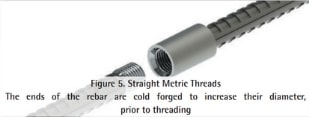
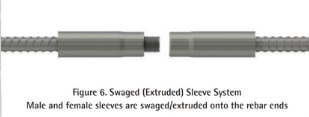
In addition, some coupler systems have in-build quality control features where by each and every connection is automatically and systematically proof loaded by the processing machinery as part of a quality control procedure.
The coupler types shown in Figure 5 and 6 are both simple to install and can be verified to be installed correctly by visual inspection, as it is clear to see when the appropriate level of male, female, thread engagement is achieved. Other types of couplers are more difficult and often impossible to visually verify that they are installed correctly.
Couplers Requiring Rebar End Preparation
Coupler systems requiring rebar end preparation are usually the most cost effective, but their use needs to be pre-planned as the bar end processing usually occurs at the rebar cut and bend depot and supplied to site with the appropriate rebar. These cut and bend fabricators would usually hold a stock of couplers and have the machinery to process the bar ends to suit the coupler system.
Standard Couplers
A standard coupler configuration required the rotation of the adjoining rebar to make the connection.
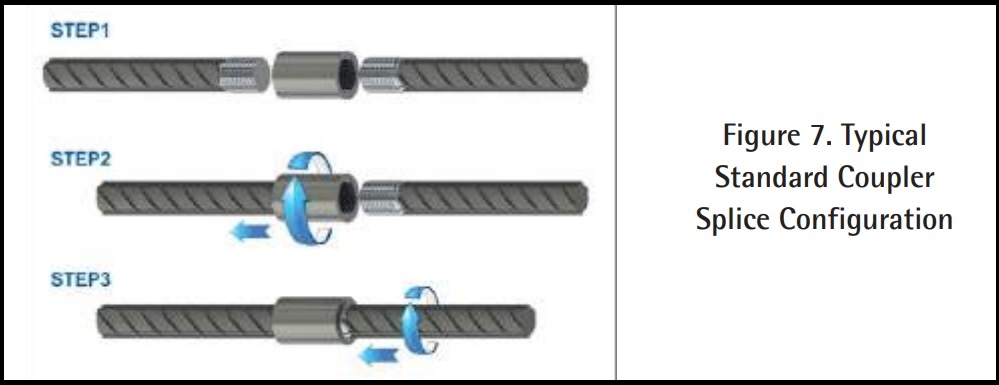
Positional Couplers
A typical positional coupler configuration has an extended length of thread onto the ribs of one rebar allowing the coupler unit to be fully screwed onto one bar, before being screwed back onto the adjoining rebar. This type of system is often supplied with a locknut in order to lock the assembly into position without rotating the rebars.
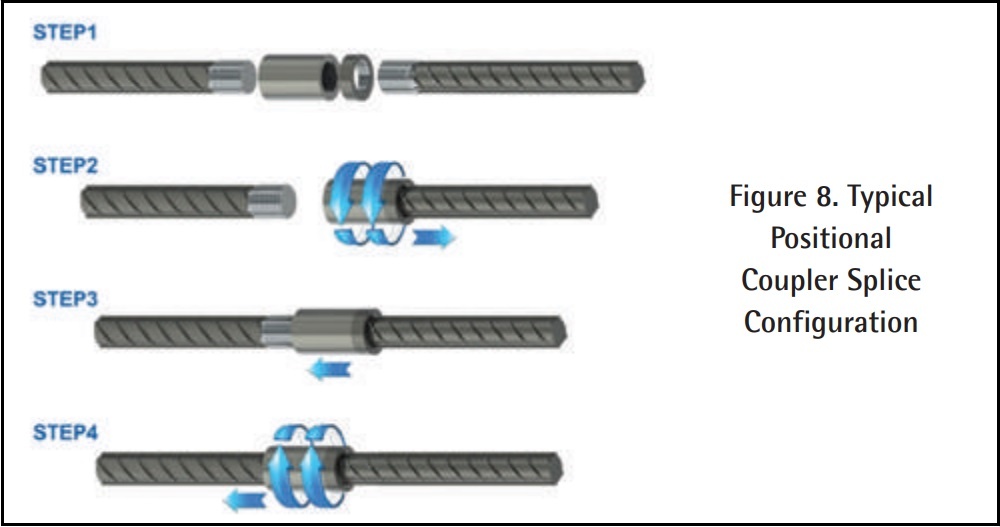
Bridging Couplers
Where the ends of the connecting rebar cannot be brought together, a bridging coupler system can be used in order to bridge a small gap between the ends of the rebar.
Transitional Couplers
Transition coupler systems are designed to connect rebar of two different diameters. Sometimes this can be done by applying a smaller thread on the larger diameter bar, and other times by using a transitional coupler, as shown in Figure 8. If couplers are used to connect rebar of different diameters, it is usual for the performance requirements are based on the smaller of the two rebar diameters used.

Rebar Coupler Requirements for use in India
IS 16172 covers the performance requirements for rebar couplers. The standard also describes the testing methods, rebar coupler classification, workmanship, sampling and criteria for conformity, identification and marking. In addition, Annex A describes some of the different types of rebar coupler technologies available.

Performance Requirements
All rebar couplers are required to comply with the Indian rebar coupler standard IS 16172. This details the following performance requirements:
- Static tensile load
- Ductility
- Slip (residual elongation)
- Cyclic tensile loading
- Low Cycle fatigue loading
In addition, there is an optional high cyclic fatigue loading requirement. All testing should be conducted in accordance with Annexes B, C, D and E of IS 16172.
(This article is authored by Richard Goodman, Technical Manager, Dextra).
Cookie Consent
We use cookies to personalize your experience. By continuing to visit this website you agree to our Terms & Conditions, Privacy Policy and Cookie Policy.




















